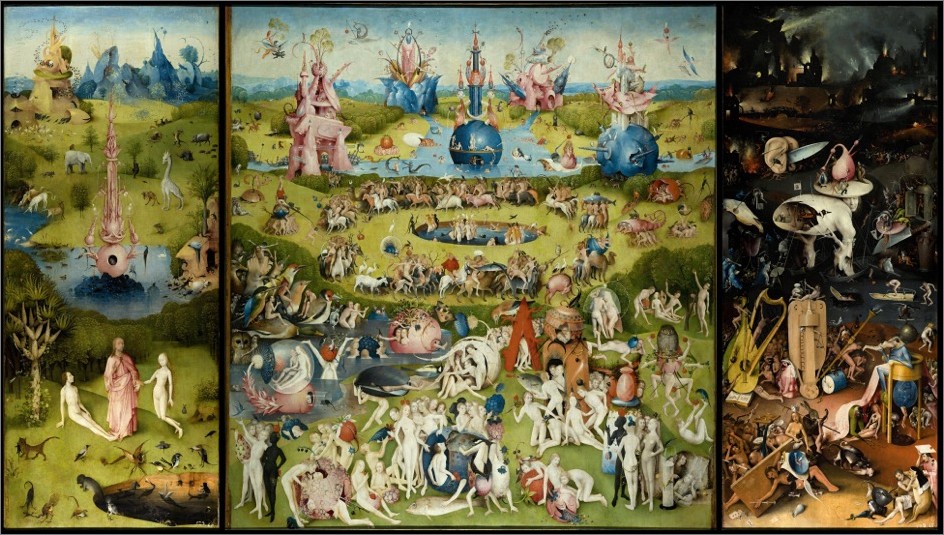背景:「北部」的意涵
阿尔卑斯山以北:尼德兰(法兰德斯 Flanders,布拉班特 Brabant),德意志(纽伦堡 Nuremberg),勃艮第(第戎 Dijon,贝里公爵领等),英格兰(较晚,荷尔拜因入宫后)
- 公爵领地,市镇与行会的赞助(patronage of
duchies , towns, and guilds) - 纸张,印刷与
知识革命(knowledge revolution, Gutenberg) - 油画(oil paint)的发展
- 北部现实主义的几个面向:幻象主义,物质性与时空投射(facets of northern realism:
illusionism, materiality, and temporal projection )
The artistic attempt to create the convincing appearance of reality on a flat surface, often through detailed observation, perspective, and light effects, so that the viewer feels as if the depicted objects or figures truly exist in space.
The focus on rendering the physical qualities of objects—their texture, surface, and tangible presence (like glass, metal, cloth, or wood)—so vividly that the viewer becomes aware of their concrete, material existence.
The way artworks bring sacred or historical events into the viewer’s own time, making the past (e.g., biblical episodes) appear as if it unfolds in the present moment and immediate environment.
神性在尘世
尼德兰绘画(Netherlandish painting)中的基督教现实主义(法兰德斯地区 Flanders,c.1400 - 1500)
- 时空置换:此时此地的基督 — 让过去显现在现时
- 身体置换(bodily displacement):彼时彼地的观者 — 让观者卷入画面的领域
- 神秘性的物质化(materializing mystery):象征性细节(symbolic details)
- 神秘性的物质化:过剩的细节(superfluous details)
=>《梅洛德三联画》(The Mérode Triptych),祭坛画,Robert Campin,c.1425-30

=>《根特祭坛画》,又称《敬拜神秘之羔羊》(The Ghent Altarpiece),Jan and Hubert van Eyck,1432
人性在尘世
个人主义与肉身(individualism and the body)
凡·艾克的世俗肖像(Van Eyck’s secular portrait)=>《戴红头巾的男子肖像》(Man in a Red Turban),疑似为凡艾克的自画像,1433
=>《阿诺菲尼的婚礼》(The Arnolfini Portrait),描绘世俗贵族夫妇,1434
=> 《人间乐园》(The Garden of Earthly Delights),c.1480-1515

法国早期文艺复兴绘画与雕塑
勃艮第地区,c.1400 - 1420
雕像中的光学与情绪现实主义(optical and emotional realism)An artistic approach that reproduces how things appear to the eye, using light, shadow, and texture to create a lifelike impression based on visual experience rather than ideal forms.
=> 摩西之井(The Well of Moses),Claus Sluter,彩绘石雕喷泉(painted stone fountain),顶部的 Crucifix scene 雕像遗失
=> 勇敢的菲利普二世棺椁下的哀悼者(mourners on the tomb of Philip the Bold),Claus Sluter
=> 《贝里公爵的豪华时祷书》(The Very Grand Book of Hours for the Duke of Berry)中的日历页,Limbourg brothers,彩绘手抄本
本节名录
- 12th century: paper technology arrives in Europe, after being invented in China by the 2nd century B.C.
- 1455: Johannes Gutenberg (古腾堡) publishes a Bible in Germany, the first western book printed on a “moveable type” printing press (活字印刷); this, combined with paper production, sets off a revolution in the dissemination of knowledge (知识的传播)
- oil paint: a painting technique in which pigments are bound with plant oil (植物油), usually linseed (亚麻籽); artists used it from the 12th century, but it only became a dominant technique in the 15th century, starting in the Netherlands [note that the linen plant produces edible seeds, edible oil (from the seeds), and the fiber for making linen (亚麻,由亚麻纤维制成)]